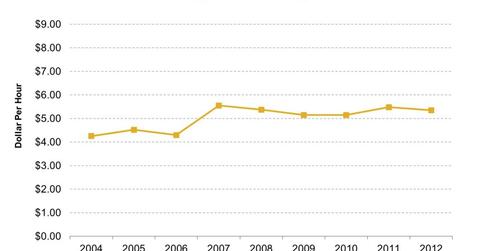Why do most workers at McDonald’s work part-time?
Part-time work is most likely an industry-wide characteristic within the food retail business.
Dec. 11 2013, Published 12:00 p.m. ET

Most workers at McDonald’s work part-time
The number looks odd and seems absurd, because $5.14 per hour is below the federal minimum and hasn’t been adjusted for employees that work at headquarters and not at restaurants. But no matter how many times you calculate the figure, it’s right. So you would later have to learn that McDonald’s mostly hires part-time workers who don’t work full-time (40 hours a week), instead working around 20 to 30 hours. Why would McDonald’s (and possibly other restaurants) hire this way?
Obama’s healthcare reform
Obama’s healthcare reform acts require all employers to provide health benefits to employees who are working full-time. As one of the largest components of cost, fast food companies and other service industries aren’t so willing to offer jobs on a full-time basis, since putting workers on full-time could lead to increases in costs. On the other hand, fewer retraining and rehiring expenses could decrease costs for employers.
Industry-wide characteristic
But that probably isn’t the only reason why the industry favors part-time workers. Part-time work is most likely an industry-wide characteristic within the food retail business. Assuming work hours of 40 hours per week and 50 weeks per year, McDonald’s historic wage per hour hasn’t changed drastically. While it grew from just about $4.50 per hour in 2006 to ~$5.50 per hour post-2006, the figure has fluctuated around $5.50 per hour since then.
Younger workforce
Reliance on a part-time workforce possibly links to the restaurant industry’s younger workforce compared to other industries. In April 2013, Andrew Moesel of the New York Restaurant Association spoke on MSNBC’s Up With Chris Hayes. He argued that for American workers, low-wage fast food work is only an entry-level starting point. “The restaurant industry is a launching pad,” Moesel said, according to the National Hour and Wage ClearingHouse’s website. Granted, about 50% of those working at or below prevailing federal minimum wage are below 25, which means those aged 25 and older make up the the other half of workers, based on a government report.
Diction can be dangerous
Yet several media are drawing people’s attention to the wrong statistics—and sometimes to the wrong words. One commentator on the National Hour and Wage ClearingHouse wrote in response to what Andrew Moesel said, “But, according to new report out Thursday, that claim doesn’t hold water. In fact, the Center for Economic and Policy Research report finds that people aged 25–54 hold the largest share of fast-food worker jobs in the U.S. Eleven percent of workers earning $7.25 an hour or less are older than 20, as are 68 percent of workers earning between $7.26 and $10.09.”
